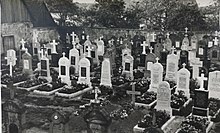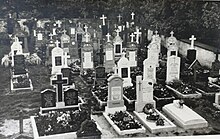St. Emmeram (Sammenheim)
The St. Emmeram Church is an Evangelical Lutheran church in Sammenheim , a district of the municipality of Dittenheim in the Weißenburg-Gunzenhausen district in Central Franconia . The church, consecrated to the Emmeram of Regensburg , belongs to the Evangelical Lutheran Dean's Office in Heidenheim and is registered as a monument in the Bavarian list of monuments under monument number D-5-77-122-14 . The postal address is Sammenheim 24a . The church is located on the outskirts of the village at an altitude of 457 meters above sea level . The choir tower church was built in the margrave style by Johann David Steingruber from 1756 to 1762. The tower has a domed dome and was built in 1762.
History of the parish
As early as March 23, 1274, Pope Gregory X added the parish of Sammenheim to the Heidenheim monastery . In a copy of the document, it was authenticated by the Wülzburg abbot Wilhelm on Urban Day (= 25 May) 1449. Thus the Heidenheim abbot was the actual pastor. He had the parish provided by monks or world priests.
Introduction of the Reformation
In a report from August 25, 1528 it is said that Pastor Nikolaus Goppel (Gopold?) "Preaches evangelically". He came from Nördlingen and had studied at the universities of Freiburg, Basel, Wittenberg and Leipzig. In the summer semester of 1513, in which he was in Wittenberg, he had probably seen Martin Luther as a professor. It is not known when he was ordained a priest and whether he came to Sammenheim straight away after graduation. In 1535 he became a sub-chaplain in Gunzenhausen . Pastor Goppel was followed in 1535 by Simon Zimmermann, a former Heidenheim monk. In the same year he moved to Kurzenaltheim . He was followed by Heinrich Haffner, also a former Heidenheim monk, who married in Heidenheim in 1535 and worked in Sammenheim until 1569.
Parish description of Sammenheim from 1912
When the first church was built here and where it stood can no longer be traced. It was probably not in the present location, but in the garden belonging to house number 52 (today number 37); because the owner of this house is still called "the Kirchbauer" and the hill is called "the Kirchbuck". Even in terms of its current size and design, the square was suitable for a church and cemetery.
At the church that existed in front of the present church, the year 1202 was on the altar panel, on which the three saints St. Wolfgang , St. Emmeram and St. Leonhard were depicted, under the figure of St. Emmeram can be related to this altar panel, it follows from this that it was first set up in a church that had stood in 1202.
In the church that stood in front of the present church, in its current location, the year 1494 was written to the left of the altar in the front of the choir at the place where the sacrament house was in Catholic times it can be assumed that this is the year of their construction.
Since in 1589 the "lookup" for the church clock was "raised" by the local community blacksmith Leonhard Huter for 27 guilders, the clock itself must have been attached earlier.
Neither the demolition of the old church, the laying of the foundation stone nor the completion of the new church held a church celebration: "not a syllable was heard in - culto publico (public celebration) -, no prayer, no ... preaching".
Pastor Frobenius brought this up in a "convenable" way at his first church consecration sermon, which he held there.
The following year, on May 10, 1762, the old tower began to be demolished. Pastor Frobenius held an extraordinary service. They sang: "In all my deeds". The talk about Genesis (Genesis 11: 1) lasted over an hour. The tower was finished in October 1762, the masons were finished on September 29th, the carpenters on October 8th, and the tower decker on October 30th.
Bells
Four bells hang in the church tower . The largest bell (12 o'clock bell, peace bell or death bell with strike tone a 1 ) was cast around 1500 and bears the Latin inscription "Ave Maria, gratia plena, Dominus tecum". Presumably it comes from the foundry of the Glockengießer family in Nuremberg.
The second largest prayer bell, the 11 o'clock bell, was cast in 1999 with the tone c 2 . A crucifixion group was applied and the inscription: WE THANK YOU, LORD JESUS CHRIST, THAT YOU DIED FOR US.
The third largest baptismal bell (tone d 2 ) was cast by Johann Ernst Lösch in 1780 .
The smallest bell, resurrection bell with tone f 2 , was cast in 1999. The bell is decorated with the image of the risen One. The inscription reads: I AM WITH YOU ALL DAYS UNTIL THE END OF THE WORLD.
The prayer and resurrection bells were cast in September 1999 by the Bachert bell foundry in Heilbronn, solemnly collected at the entrance to the town on October 23, 1999 and brought to the church and consecrated on the Reformation Festival on October 31, 1999, and the entire bell was once again put into the service of God.
Since November 2000 the old 11 o'clock bell (prayer bell with tone b 1 ) of the former three -part peal has been located in the cemetery .
The inscription reads: TOO JOY AND ALSO TOO SORRY, LET MY GELEUT SOUND * JOH * CON * FISCHER PF (arrer) * NICOLAUS AND ALEXANDER ARNOLDT HAVE CASTED ME ANNO * 1 * 7 * 15.
During the Second World War , this bell was transported to the Hamburg bell cemetery together with the 12 o'clock bell . The little baptismal bell stayed in the tower. Fortunately, in 1947 the two bells found their way back to Sammenheim via a detour from Ingolstadt. On April 11, 1999, the familiar three-part bells sounded for the last time.
organ
history
When the organ was first purchased in 1696, the consistory showed a negative attitude:
What do in the country anietzo almost every village strives for an organ, which not only makes a lot of money, which is far better and more useful to the schoolmasters and their poor salaries / to thereby create great advantage for young people, and to be able to entertain / or to support the churches themselves ... would like to spend. .., but it would also be harmful to the singing, because the schoolmaster could no longer conduct and watch him from his desk while playing. It therefore ordered that approval must first be obtained.
Nikolaus Prescher (1669–1712), Nördlingen , built a new organ in 1696 with one manual and eight stops (?). The cost of the loan purchase amounted to 88 guilders and 2…. It was inaugurated on the 3rd Sunday of Advent in 1696. In 1698 a chord with the painter Jacob burner Wallerstein became the version closed the organ. The double doors were painted with King David including a harp and asaf . The instrument was sold to Dürrnbuch in 1764 and repaired by Caspar Moritz Nößler (1724–1777), Heilsbronn , and installed there; the case is preserved. In the same year a new building was probably carried out by Nößler. In 1873 the collection comprised twelve registers. Due to the poor condition, it was converted by an unknown company in 1890.
The current organ was built in 1937 by the Steinmeyer company from Oettingen in Bavaria with a free-standing console and has 13 registers on two manuals with pedal and a total of 818 pipes. The play and stop action is built in the form of a pneumatic pocket drawer . The richly decorated five-part organ prospect with three round towers and pointed fields in rococo style dates from the time the church was built and was created by the "Prince Onolzbach Court and Country Organ Maker" Caspar Moritz Nößler.
Disposition
The disposition of the Steinmeyer organ from 1937, Opus 1643, is as follows:
|
|
|
||||||||||||||||||||||||||||||||||||
- Coupling : II / I, I / P, II / P
- Playing aid : Tutti step
literature
- Gotthard Kießling: Weissenburg-Gunzenhausen district (= Bavarian State Office for Monument Preservation [Hrsg.]: Monuments in Bavaria . Volume V.70 / 1 ). Karl M. Lipp Verlag, Munich 2000, ISBN 3-87490-581-0 , p. 80 .
- Organ monuments in Middle Franconia, Hermann Fischer, Theodor Wohnhaas, No. 190
- Church messenger for Sammenheim / Sausenhofen, Pentecost 1996
- 250 years of St. Emmeram, how did Sammenheim become Protestant? Werner Kugler
Web links
- Sammenheim / Sausenhofen - Whitsun 1996 Location of the church in the Bavaria Atlas of the Bavarian State Government ( information )
Individual evidence
- ↑ Evangelical Lutheran Parish Church St. Emmeram , Bavarian State Office for Monument Preservation (PDF, accessed on November 19, 2016)
- ↑ Topographic maps , Bavarian Surveying Office ( BayernAtlas )
- ^ Hermann Fischer , Theodor Wohnhaas : Organ monuments in Middle Franconia (= 169th publication of the Society of Organ Friends ). 1st edition. Ulrike Schneider Rensch Orgelbauverlag, Lauffen am Neckar 2001, ISBN 3-921848-08-3 , p. 238 .
Coordinates: 49 ° 3 '15.1 " N , 10 ° 45' 4.7" E













